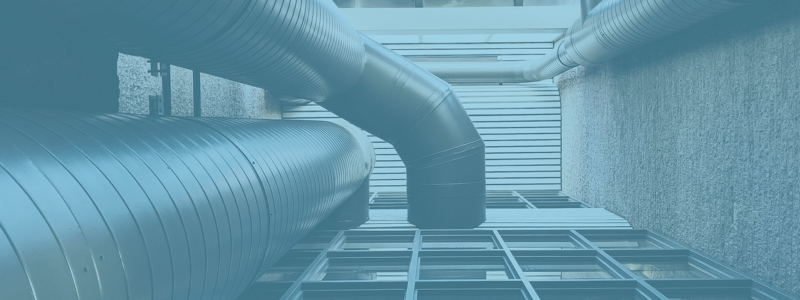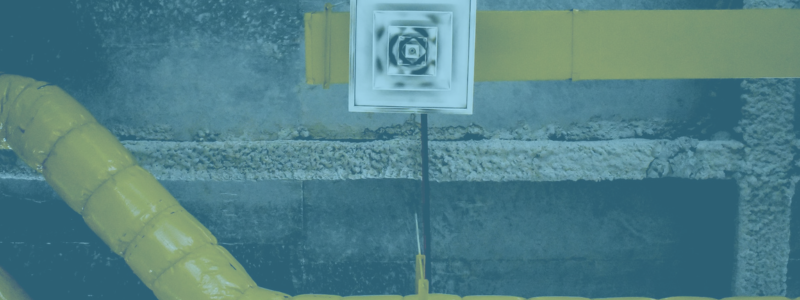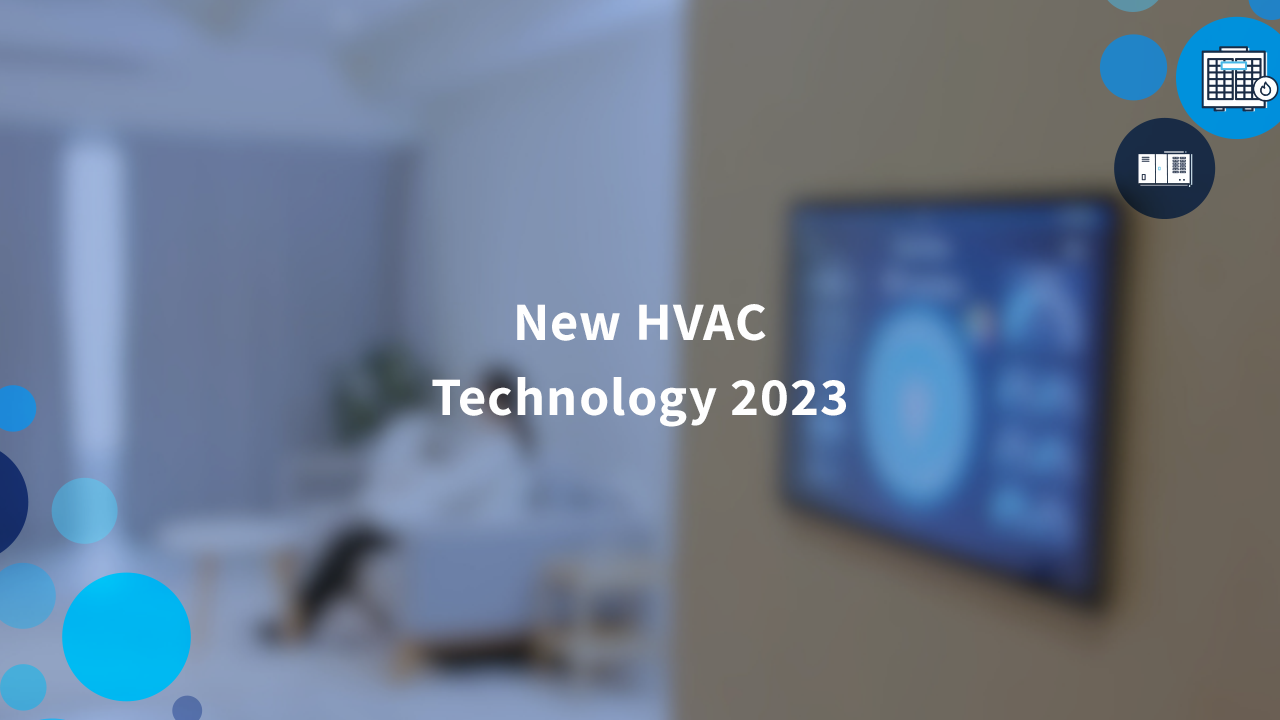The future of heating, ventilation, and air conditioning has arrived, and it’s brought the latest technology trends emerging in 2023. From smart systems to energy efficiency, these groundbreaking innovations hold the potential to revolutionize the HVAC landscape, elevating comfort levels and promoting environmental sustainability like never before.


What is HVAC Technology?
When someone says, “HVAC technology,” they’re referencing the systems and processes that regulate indoor environments through heating, ventilation and air conditioning. Those systems are composed of a wide range of equipment, ranging from furnaces and air conditioners to heat pumps and air purifiers. The technology is essential for maintaining optimal temperature, humidity and air quality in a variety of settings, including residential, commercial and industrial buildings.
It might all sound pretty high-tech, but HVAC technology is essential for anyone who wants to create comfortable and healthy indoor environments. Efficient heating and cooling systems can significantly impact occupants’ well-being and productivity by maintaining appropriate temperature and humidity levels. Moreover, effective ventilation and air purification contribute to improved air quality, reducing the risk of respiratory problems and allergic reactions.
HVAC technology isn’t some sort of Space Age innovation. Its use actually dates to ancient civilizations when early Romans and Greeks employed primitive heating and cooling methods. However, it was the advent of the Industrial Revolution that truly transformed the industry, with the invention of modern heating systems and the introduction of air conditioning in the early 20th century. Over the years, advancements in HVAC technology have focused on improving energy efficiency, reducing environmental impact and incorporating smart controls for greater convenience and flexibility.
Latest HVAC Technology Trends
The HVAC industry is witnessing a range of cutting-edge technology trends in 2023.
These developments potentially could redefine energy efficiency and enhance users’ experiences. Keep reading to learn all about how groundbreaking developments like smart HVAC systems, variable refrigerant flow systems, geothermal heating and cooling, as well as advanced air purification solutions can benefit your property, your pocketbook and even your health.
Smart HVAC Systems
Smart HVAC systems can encompass a variety of advanced heating, ventilation and air conditioning technologies that leverage sensors, automation and machine learning algorithms to optimize performance, energy efficiency and, of course, comfort. These systems intelligently adapt their operation based on environmental factors, user preferences and even occupancy patterns, integrating with other smart devices and home automation platforms.
Having trouble picturing a smart HVAC system in action? Consider the following examples of the latest 2023 smart HVAC technologies:
- Learning thermostats can study user behavior and preferences to create customized temperature schedules, improving energy efficiency and reducing energy waste.
- Zoning systems allow a user to control the temperature and airflow in different areas of a building, using smart sensors and dampers to enhance overall comfort and energy savings.
- Advanced air quality monitoring and management tools measure indoor air pollutants, humidity and allergens, adjusting ventilation or activating air purification equipment to maintain a healthy indoor environment.
- Predictive maintenance alerts monitor system performance and notify users of potential issues before they become major problems, extending the life of the equipment and preventing costly repairs.
- Demand-controlled ventilation automatically adjusts the amount of fresh outdoor air brought into a building based on occupancy and indoor air quality, providing optimal ventilation while reducing energy consumption.
Despite the numerous advantages offered by smart HVAC systems, they also present certain challenges and limitations. The initial cost of installation can be higher compared to traditional systems, as they often require additional sensors and components. Integrating smart HVAC systems with existing infrastructure also might be more complex, potentially requiring specialized skills and expertise.
As with any technology that relies on connectivity, smart HVAC systems could be vulnerable to cybersecurity risks, necessitating robust security measures to protect user data and system integrity – a 21st-century complication that doesn’t arise when using most traditional HVAC equipment.


Variable Refrigerant Flow Systems
Variable refrigerant flow systems are emerging as a notable HVAC technology trend in 2023.
These systems provide simultaneous heating and cooling to different zones within a building, using refrigerant as the heat transfer medium. VRF systems offer better efficiency, zoning capabilities, and comfort levels than traditional HVAC systems. They are highly versatile, making them suitable for a wide range of applications, from residential homes to commercial office spaces, and even large-scale industrial facilities.
VRF systems typically consist of a single outdoor unit connected to multiple indoor units, offering users the flexibility to customize indoor climate control based on their specific needs. Property owners who employ a VRF system enjoy a variety of benefits, including:
- Enhanced energy efficiency can be achieved with VRF systems. Because they can modulate the amount of refrigerant flowing through the system, providing precise temperature control and reducing energy waste, variable refrigerant flow systems offer enhanced efficiency.
- Simultaneous heating and cooling is a lauded benefit of VRF systems. The ability to deliver both heating and cooling within different zones allows for greater comfort and customization is a popular function.
- VRF also offers property owners flexible installation since they can accommodate a wide range of building designs and layouts, they feature compact indoor units, and they can extend refrigerant piping over long distances.
- VRF systems are known for their quiet operation. Both indoor and outdoor units are designed for minimal noise output, providing a more peaceful indoor environment.
- VRF systems carry reduced maintenance costs. With fewer moving parts and the absence of ductwork, they can have lower maintenance costs compared to traditional HVAC systems.
Before investing in a VRF system, however, property owners should be aware of potential challenges. The initial cost of installation can be higher compared to conventional HVAC systems, as VRF requires more advanced components and skilled installation professionals.
Plus, some building owners could face compatibility issues when retrofitting existing structures with VRF technology. It also should be noted that while VRF systems generally have lower maintenance costs, servicing these systems can be more complex due to their intricate design and the need for specialized training and experience.
Geothermal Heating and Cooling
Geothermal HVAC systems use the planet’s natural energy to heat and/or cool buildings, providing significant energy savings and reducing the reliance on fossil fuels. The systems leverage the stable temperature of the Earth to transfer heat to or from a building, using ground-source heat pumps to circulate heat-absorbing or heat-releasing fluids. Geothermal systems are versatile and can be installed in various settings, from residential homes to large commercial buildings, schools and healthcare facilities.
There are tons of advantages to controlling your indoor climate with a geothermal heating and cooling system, including:
- Geothermal systems are considered high energy efficiency. They can provide up to 70% energy savings compared to traditional HVAC systems since they use of the Earth’s stable temperature as a heat source.
- If you’re looking for an environmentally friendly HVAC option, look no further than geothermal heating and cooling: By utilizing renewable energy and reducing greenhouse gas emissions, geothermal systems contribute to a lower carbon footprint.
- Geothermal systems are known for their longevity since they typically have a longer lifespan compared to traditional HVAC equipment, with heat pumps lasting up to 25 years and underground piping lasting 50 years or longer.
- Geothermal heating and cooling system operators enjoy low operating costs. The energy savings offered by geothermal systems result in lower operating costs over the life of the system.
- Geothermal system users also enjoy its quiet operation. With fewer moving parts, these HVAC systems operate silently, providing a more comfortable indoor environment.
Geothermal heating and cooling system users might enjoy numerous benefits offered by this HVAC technology trend, but they also must consider a few potential disadvantages. The initial cost of installation can be higher than traditional HVAC systems due to the need for specialized equipment and the excavation required for underground piping.
Geothermal systems also might not be suitable for all locations since factors like soil composition, groundwater levels and the availability of space for installation can impact system performance. As with so much other advanced HVAC technology, installing, servicing and repairing geothermal systems HVAC systems might require specialized training and expertise.
Air Purification Systems
Air purification systems are designed to remove allergens, pollutants and other harmful particles from indoor air, providing a healthier living and working environment. These systems might use various technologies, including HEPA filters, UV-C light, activated carbon filters and ionization, to capture and neutralize airborne contaminants. Air purification systems can be integrated into central HVAC systems or function as standalone units, making them suitable for a range of homes, offices, schools, healthcare facilities and all sorts of other buildings.
Wondering why you should install an air purification system on your property? You probably can think of plenty of benefits on your own, but don’t forget to consider the following:
- Air purification systems offer improved indoor air quality. By removing allergens, pollutants, and harmful particles, air purification systems help create a healthier environment for occupants.
- When property owners install air purification systems, they experience a reduction of allergens. Air purifiers can capture and remove common allergens such as pollen, dust, pet dander and mold spores, providing relief for allergy sufferers.
- Air purification systems also help to eliminate odors and volatile organic compounds. Activated carbon filters can help neutralize unpleasant odors and harmful VOCs released by various household products and materials.
- These systems are popular among consumers because they provide protection against airborne pathogens. Some air purification technologies, like UV-C light, can neutralize bacteria, viruses and other microorganisms, reducing the spread of infectious diseases.
- Air purification systems also provide enhanced HVAC system performance. By removing particulates from the air, air purifiers can reduce the strain on HVAC system filters and improve overall system efficiency.
Despite the range of benefits offered by air purification systems, users might encounter a few hurdles as they pursue their dreams of perfectly purified air. The initial cost of purchasing and installing an air purification system can be substantial, especially for advanced technologies like UV-C light and HEPA filters. Likewise, regular maintenance, including filter replacement, is necessary to ensure optimal performance, which can add to ongoing expenses.
Meanwhile, some air purifiers, particularly those using ionization or ozone generation, could produce undesirable byproducts, negatively impacting indoor air quality if not properly managed. Of course, choosing the appropriate air purification system and technology for a specific application requires a thorough understanding of individual needs and environmental factors, so expert consultation might be necessary.


The Future of HVAC Technology
The HVAC industry continues to undergo rapid transformation as it moves into the future, driven by the increasing demand for energy-efficient and environmentally friendly solutions. Technological advancements are pushing the boundaries of what HVAC systems can achieve, with innovative designs and smart integration becoming the norm.
As smart technology continues its rapid evolution, advanced AI algorithms will play a significant role in analyzing collected data to optimize HVAC performance and predict potential maintenance issues before they escalate, reducing downtime and increasing overall efficiency.
Another area of focus in the future of HVAC tech relates to the development and adoption of eco-friendly HVAC technologies. As the global community increasingly prioritizes reducing carbon emissions and embracing renewable energy sources, innovations in solar and geothermal technologies are expected to play a more prominent role in HVAC systems, providing sustainable and cost-effective alternatives to conventional methods.
In addition to environmental concerns, advances in materials science are set to revolutionize HVAC system design. Nano and aerogel-based insulation materials, with superior thermal performance and reduced thickness, will enable the development of smaller, more efficient HVAC units. These advancements not only allow for sleeker and less obtrusive installations but also contribute to reducing the overall carbon footprint of HVAC systems.
Just as influentially, increasing urbanization and the need for space-saving solutions will impact the future of HVAC technology. Architects and engineers are collaborating on integrated, multifunctional HVAC systems that not only blend seamlessly with modern building designs but also utilize space more efficiently. Vertical farming, green roofs and living walls are just a few examples of how HVAC technology can be integrated into urban environments, offering practical and aesthetic benefits.
The HVAC industry is on the cusp of a new era marked by smarter, greener and more efficient systems. As we move forward into 2024 and beyond, these technological advancements will not only improve the way we manage our indoor environments but also contribute to a more sustainable and energy-efficient future for all.
Motili’s Contribution to HVAC Technology
As a leader in the realms of data-driven property and HVAC asset management technologies, Motili has made significant contributions to the industry through its innovative solutions. By offering a comprehensive platform that streamlines the assessment, maintenance, repair and replacement of HVAC systems, Motili has helped property owners, facility managers and HVAC contractors maximize operational efficiency while actually reducing costs.
Motili’’s proprietary technology includes a centralized dashboard that lets users track and manage their HVAC assets across multiple locations, monitor system performance and receive alerts for preventive maintenance. By harnessing the power of data analytics and machine learning, Motili’s platform helps users optimize their HVAC systems, ultimately contributing to improved energy efficiency, reduced downtime and enhanced indoor comfort.












